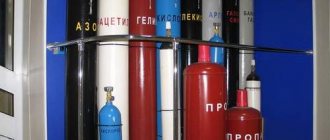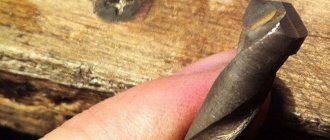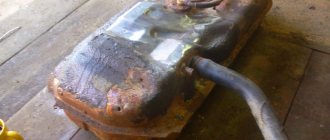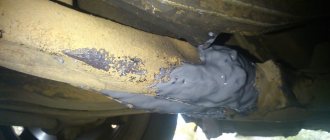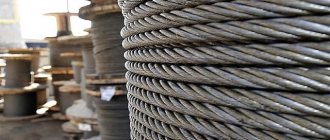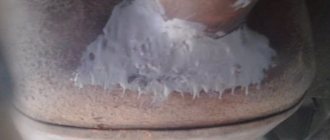The fuel tank is the main part of the vehicle's power system, responsible for storing fuel and transferring it through a system of pumps and filters to the device that prepares the combustible mixture (carburetor or injector).
Obviously, the main malfunction of gas tanks is leaks, which can appear for three reasons:
- due to the effect of corrosion on metal tanks;
- as a result of mechanical damage (strong vibrations, friction on asphalt, gravel impacts, etc.);
- as a result of natural aging of the material , for example, the gradual appearance of porosity in plastic tanks.
In practice, all factors act simultaneously, not only increasing the risk of being left without an energy source on the road, but also reducing the fire safety of the vehicle. The fuel level arrow can indicate a problem - if you notice that it moves too quickly or periodically “falls” down, it is better to stop and inspect all elements of the power system. The smell of gasoline in the cabin and the characteristic “rainbow” puddles in the rear axle area are sure signs of a leak.
Why does a gas tank leak: reasons
In Lanos and Lada Priora, the fuel tank is located under the rear seat. The main causes of damage to a gas tank include mechanical stress and metal corrosion. Holes occur when a car is driving on uneven roads, potholes, potholes and hills. An old tank often becomes rusty and rots. Cracks increase and leaks appear.
You can detect a leak in the gas tank using the panel instrument. In addition, the smell of gasoline is clearly audible in the cabin. You should stop the car, turn off the engine, check the tank and try to seal it yourself if there are no car services nearby.
Advice!
Before work, analyze the size and nature of the damage and only then choose the type of repair.
Repair methods and preliminary preparation
As you can clearly see, there are several options for repairing a crack in a gas tank.
If you want to make a full repair that will allow you to continue to operate the car without necessarily replacing the fuel tank, you need to start from the specific material used in the manufacture of the tank.
Therefore, all repair methods are divided depending on the material of the tank. The following varieties are distinguished:
- steel;
- plastic;
- aluminum.
Each of them has its own recommendations on what to do if the gas tank is leaking and you need to get rid of the damage.
But regardless of the material used, any repair work cannot be carried out when the tank is full of fuel. This is only relevant for express repairs and then in limited cases, when it is impossible to do otherwise, and there is no real opportunity to remove the tank. In this case, there is a risk of losing all the fuel and getting stuck for a long time.
If you want to make high-quality repairs, but do not want to completely change the fuel tank by buying a new tank, you need to perform several mandatory steps before carrying out work.
- Take the repair manual for your car. It should clearly indicate how specifically to remove the fuel tank on this machine.
- Based on the instruction manual, the tank must be dismantled. It is strongly not recommended to repair cracks directly on the car. Even if there is no fuel inside.
- The fuel pump must be removed from the tank. This is not difficult to do, you just need to unscrew a few fasteners. The operation and repair manual will also help here.
- From the fuel container you need to remove the plastic float of the sensor, which monitors the fuel level in the gas tank. Be very careful not to damage the float and its holder.
- Now you can drain the remaining fuel. For this, use capacious and clean containers, which can then be hermetically sealed.
- The tank must be rinsed using hot water. Cleaning is carried out with water heated to at least 50 degrees Celsius. It is not necessary to use pure boiling water.
- After draining the first water, add washing powder to a new portion of rinsing water. Repeat the procedure several times. This ensures that there is no fuel or gasoline vapor left inside, which could ignite when exposed to high temperatures. Do the last rinse with plain water, without using powder.
- Dry the tank. This is a mandatory preparation stage. Drying is completed within 24 hours.
What tools are needed for the job?
You can eliminate a leak in a car's gas tank using rubber pads, a bolt and an adhesive-based patch. Sealants, cold welding and fiberglass are also useful.
Tools for metal tank:
- spanners;
- pliers;
- sandpaper;
- screwdrivers;
- soldering iron;
- funnel, hose and container for draining fuel;
- welding machine;
- file;
- degreaser;
- cold welding.
Before work, you need to change into work clothes and put on gloves. For convenience, the tank is dismantled - it is safer to carry out repairs. But if a hole occurs on the way, then the patch will help you get to the nearest service station without removing the tank.
Material and characteristics of the metal tank
We will be considering a container made of metal, because as mentioned above, such a gas tank can be repaired. As for the material from which this container is made, in 95% of cases it is a soft steel sheet. This sheet has additional treatment, usually a secondary lead coating, which slows down irreversible corrosion processes.
The advantage of this material and the reason why it can be repaired is that when deformed, it is possible to level the metal sheet. If for any reason a gap appears in such a gas tank (for example, a breakthrough due to an accident or thinning of the material due to rust), then it can be soldered or welded.
How to fix a leak in a car's gas tank without removing it
If a fuel leak occurs on a road where there are no repair services or residential buildings, then the car should be stopped, find the hole and try to seal it. Before you start doing anything, you need to carefully inspect the tank. The hole is patched without removing the tank if it is located in an accessible place.
First, drain the remaining gasoline and dry the tank. If necessary, expand the hole to the required size with a screwdriver. The bolt is installed in the hole inside the tank, a rubber gasket is put on it from the outside and tightened with a nut. If the work is done well, the tightness is guaranteed for 3-4 years. However, it is better to replace the leaky container with a new one.
A small crack can be repaired with regular superglue. The fabric is impregnated with it and 3 layers of patches are applied, each of them well lubricated with glue. For strength, nitro paint is applied on top. You can’t drive for a long time with such a patch - it won’t last long.
Cold welding is also used. Protective gloves are put on your hands. Take out part of the welding compound, knead it in your hands like plasticine, apply it to the damaged area in 2 layers and level it.
For a plastic container, epoxy resin is used. The crack is rubbed with sandpaper, degreased, the hardener is mixed with resin, the fiberglass is smeared with resin and glued to the hole. Press firmly onto the surface, waiting until it hardens. You will need 3 such patches. During the final coating, add aluminum powder.
If the damage is below and cannot be reached, then in extreme situations a plastic bottle is used. The method is suitable for carburetor cars. Fill up with gasoline and immerse the hose from the pump into it. The bottle is fixed so that it does not move or turn over.
Advice!
Each layer of cold welding should be 2 cm wider than the previous one.
Causes of cracks
Most modern cars have a front-engine layout.
Space for the fuel tank remains only in the rear of the body. This arrangement has a number of advantages, in particular, it increases the safety of the driver and passengers. However, the location features expose the tank to negative external influences, which shorten the service life of the unit. The most common causes of defects are:
- Corrosion . Almost all cars produced in the last century were equipped with metal or aluminum tanks. Metal fatigue contributes to the appearance of microcracks, which gradually grow to full-fledged holes.
The use of plastic made it possible to completely solve the problem of corrosion. Nowadays, a metal tank can only be seen on trucks or special vehicles. The only disadvantage of plastic is its low resistance to mechanical damage.
- Mechanical damage . The quality of domestic roads leaves much to be desired. When exiting the federal highway, you may find a complete lack of road surface. Getting injured in such conditions is common.
- Power system malfunction. A rare event. It is characterized by increased pressure on the walls of the tank during operation, which can lead to the appearance of defects.
What to do if your tank leaks
The appearance of holes in the tank can cause serious trouble. We are talking not only about natural leaks of fuel, which can ignite from the slightest spark. Through the hole, road dust and debris enter the fuel, settling at the bottom. While driving, foreign elements will penetrate the fuel lines. In the worst case, the car owner will face major engine repairs.
Therefore, if a defect is detected, the tightness of the tank should be restored as soon as possible.
Plastic gas tank repair
Modern cars are equipped with plastic containers. But plastic cracks easily with any impact. Cracks form around the neck.
The tank is removed, the gasoline is drained, washed and the location of the damage is determined. Prepare for repairs:
- soldering iron;
- a piece of plastic;
- cold welding.
A piece of plastic is placed on the punched area and sealed on all sides with a soldering iron. You can take a piece of metal mesh, which is soldered into the hole.
For a small hole, use a self-tapping screw. It is inserted into the hole, a piece of rubber is placed under it and screwed.
Soldering
One of the major ways to restore a tank, close in nature to traditional welding, is to seal the damaged area using a powerful soldering iron. If the torn or chipped hole is small in size, it is not at all necessary to remove the gasoline container from the car.
To implement this method of repairing damage to the gas tank you will need:
- power supply;
- special soldering flux, fat and rosin;
- powerful hammer soldering iron (at least 200 watts).
If electricity is available and after preparing the necessary materials, the area around the breakdown site is first carefully protected and then degreased with a solvent suitable for the purpose. Immediately after this, the gas tank being repaired is washed with warm running water.
Then the surface at the site of damage is treated with a 20 percent solution of orthophosphoric acid, after which a patch of galvanized material of appropriate size is soldered onto it.
When soldering, hydrochloric acid with zinc and POS-40 type solder, used as a soldering compound, are used as a flux.
Upon completion of the work, the still hot edges of the sealed surface must be thoroughly sanded with a file and then carefully tinned. After cooling and checking the gas tank for leaks, it can be installed at the workplace .
Metal gas tank repair
Before repairs, the gas tank is removed. The process is simple. You will need wire cutters, a screwdriver, an adjustable wrench and a device for connecting rubber hoses. Drain the fuel, remove the connector with the fuel sensor and fuel pump power wires. Remove the hoses and unscrew the clamps. When the gas tank is removed, it is cleaned, washed and dried. For repairs, a soldering iron, acid and tin are used.
Fuel tank soldering:
- The deformed leak area is leveled and degreased.
- Clean the area down to bare metal; it may have been covered with rust.
- The damaged area is heated, and tin is applied with a soldering iron in 2-3 layers.
- Apply primer and paint.
Before sealing the hole with a welding machine, the tank is cleaned. If the damaged area is large, then install a metal patch and weld it on all sides. After cooling, the container is primed and painted.
Aluminum tank repair
To repair the tank you will need:
- aluminum solder HTS-2000;
- gas-burner;
- hard metal brush;
- alcohol.
Clean the damaged area of the tank from dirt and degrease with alcohol. When the alcohol dries, heat the metal surface using a gas torch. The burner flame should be small and bright blue. Move the flame constantly to heat the entire area being repaired. When the solder starts to melt, pour it over the entire repair area. Continue to heat the repair area so that the solder does not cool down and carefully scrub the metal of the fuel tank with a brush (instead of a brush you can use a nail over 200 mm long, but you will have to scrub for at least 5 minutes). This will remove the oxide layer and the solder will bond to the aluminum. Make sure the solder completely covers the repair area and there are no cracks or holes left anywhere. When it cools down, the tank is ready for use.
What to do if your tank leaks
It is important to recognize the depressurization of a gas tank as early as possible, because otherwise there is a threat to the safety of the life of the driver, passengers and others. This malfunction is indicated by a strong smell of gasoline inside the car, fuel consumption higher than usual and the formation of puddles under the car. Having discovered any of the signs or a crack itself, the driver must know how to fix a gas tank leak in order to avoid a fire.
- Stop the vehicle and turn off the ignition to avoid exposure to high temperatures and sparks.
- Empty the gas tank by pouring the fuel into an empty container.
- Identify the location of the breakdown.
- Most often, the bottom of the tank is damaged; such damage can be repaired yourself. If a hole has formed on the side and is difficult to reach, the tank will have to be removed.
- Clean the crack and the spaces around it with a brush and rag.
- If possible, level the surface and remove traces of corrosion if present on the metal.
- Begin temporary or permanent repairs to the gas tank or transport the vehicle to an auto repair shop.
Repairing gas tanks in auto repair shops is an expensive service, but fixing the defect yourself will cost much less. However, in case of severe damage, it is more rational to purchase a part.
Fiberglass + epoxy
There is no need to penetrate inside the tank - just apply a repair patch on top. To restore the damaged surface you will need fiberglass and epoxy resin. Even a beginner can do the repairs with his own hands.
Work must be carried out in the following order:
- thoroughly clean and degrease the surface to be repaired;
- soak the fabric generously with resin;
- stick the material onto the hole.
Here it is better to use two layers of repair material. After completing the work, it is advisable to treat the patch with an anti-rust agent or paint it with car paint.
How to check a gas tank for leaks after soldering
To understand whether the repairs are sufficient, you should check the tightness of the gas tank.
- The tank is filled with water and left for a day: if there are no leaks or puddles, then proceed to a more detailed check.
- To understand whether the completed seam will withstand pressure, the water tank is turned on its side: if the attachment point does not diverge and liquid does not leak, then the product is sealed.
- Another method involves filling the tank with water, leaving only a hole for the pump, and applying a soap solution on top: if there are no bubbles, then there are also no leaks.
- In rare cases, a gas tank is completely immersed in water: if the walls do not allow drops to pass through, then the tank can be considered sealed.
So, holes in metal or plastic fuel tanks are a fairly common occurrence. There are many restoration methods, so in case of minor damage, it is better to repair the gas tank yourself.



